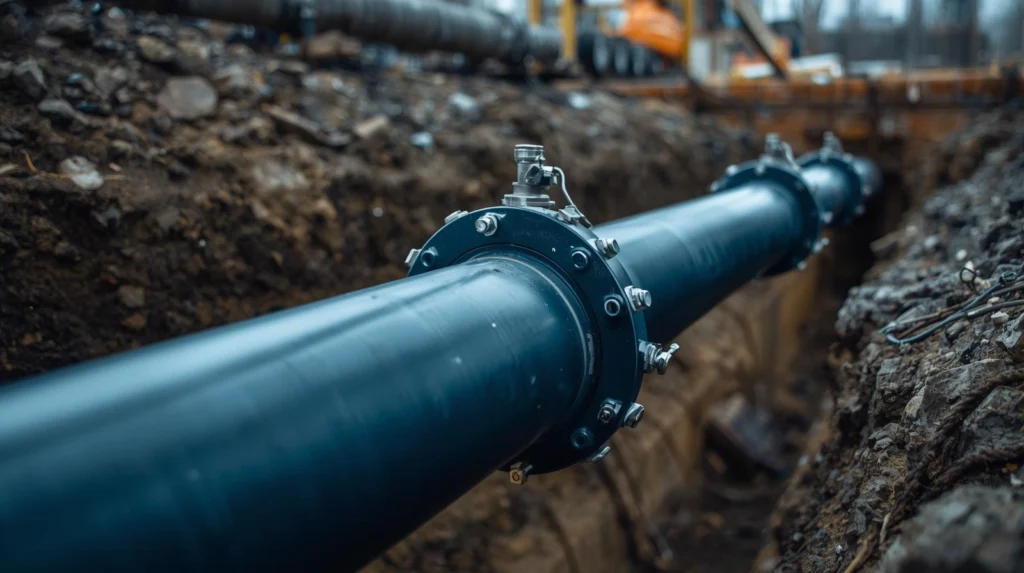The Critical Need for Reliable Gas Infrastructure
Are you concerned about the longevity, efficiency, and safety of your gas network? You’re not alone. Gas network systems are the backbone of energy distribution, serving millions of homes and businesses worldwide. However, ensuring their reliability has never been more important, especially with increasing environmental challenges and the need for sustainable solutions. Enter MDPE (Medium-Density Polyethylene) pipes—an emerging solution revolutionizing gas networks across the globe.
A staggering 10% of global gas distribution infrastructure is outdated, resulting in frequent leaks, inefficiencies, and costly repairs. MDPE pipes offer a durable, cost-effective alternative to traditional materials, providing safer and more sustainable gas network solutions. In this blog post, we’ll explore the numerous advantages of MDPE pipes, how they’re reshaping gas distribution systems, and why they should be your top choice for gas networks.
1. What Are MDPE Pipes and Why Are They Used in Gas Networks?
What Makes MDPE Pipes Different from Other Materials?
MDPE pipes are made from medium-density polyethylene, a thermoplastic polymer. Unlike traditional materials like steel or cast iron, MDPE offers unique properties like flexibility, corrosion resistance, and ease of installation. These pipes are ideal for gas distribution because they can withstand high pressures, are non-corrosive, and have a long service life. Their lightweight nature makes them easier and quicker to install, reducing labor and downtime costs.
Key Benefits of MDPE Pipes in Gas Networks:
- Corrosion Resistance: Unlike metal pipes, MDPE pipes do not corrode, ensuring a longer lifespan.
- Flexibility: Their flexible nature allows for easier installation in uneven terrain.
- Leak Resistance: The smooth internal surface of MDPE pipes minimizes friction loss, improving gas flow and reducing the risk of leaks.
2. How Do MDPE Pipes Contribute to Improved Safety?
Ensuring Leak-Free Operations
Safety is paramount in gas distribution, and MDPE pipes excel in this area. Their robust construction and resistance to corrosion significantly reduce the risk of pipe failure, leaks, or ruptures. Unlike steel, which can corrode over time and lead to hazardous gas leaks, MDPE remains unaffected by environmental factors like moisture, salt, and chemicals commonly found in soil.
In fact, studies have shown that MDPE pipes have a 70% lower risk of leaks compared to traditional steel pipes. This means fewer hazardous incidents and safer operations for both workers and residents.
Pro Tip:
Proper installation is crucial to ensure the long-term safety of MDPE pipes. Ensure the use of correct fittings and jointing methods to avoid weak spots that may compromise safety.
3. The Environmental Benefits of MDPE Pipes
How MDPE Pipes Promote Sustainability in Gas Distribution
MDPE pipes not only offer physical advantages but also contribute significantly to environmental sustainability. Their resistance to corrosion and reduced need for frequent maintenance mean less resource consumption over time. Additionally, the lightweight nature of MDPE reduces the carbon footprint associated with transportation and installation, as fewer materials and resources are required.
Moreover, MDPE pipes have a lower environmental impact during their production and installation phases compared to traditional materials. This is crucial in today’s environmentally conscious world, where the push for green solutions in infrastructure is stronger than ever.
4. Cost-Effectiveness: Why MDPE Pipes Save Money in the Long Run
Reducing Maintenance and Replacement Costs
One of the primary reasons MDPE pipes are becoming a go-to solution in gas networks is their cost-effectiveness. Traditional gas pipes, especially steel, are prone to corrosion, leading to frequent maintenance and replacement costs. In contrast, MDPE pipes can last for decades without the need for costly repairs. Their resistance to corrosion and chemicals, combined with low maintenance requirements, results in significant long-term savings.
Additionally, MDPE pipes are relatively inexpensive to manufacture and install. Their lightweight nature makes transportation and handling easier, reducing installation costs. With MDPE, the total cost of ownership is lower than with traditional gas distribution systems, making it an attractive option for gas utilities.
5. The Durability of MDPE Pipes: How Long Do They Last?
Extending the Lifespan of Gas Networks
MDPE pipes are known for their impressive lifespan, typically lasting 50 years or more under normal operating conditions. Their resistance to corrosion, UV damage, and physical wear ensures that they provide long-term, reliable performance with minimal degradation. For gas networks, this translates to fewer repairs, reduced downtime, and a more reliable infrastructure.
Case Study: A large gas utility in the UK switched from traditional steel pipes to MDPE pipes for a new gas distribution network. After 20 years, the MDPE pipes were still performing optimally, while the old steel pipes required multiple costly replacements.
6. Installation of MDPE Pipes: Faster, Simpler, and More Efficient
Streamlining the Installation Process
One of the biggest advantages of MDPE pipes is the speed and ease of installation. Unlike traditional materials like steel or cast iron, which require welding or threading, MDPE pipes are often joined using electrofusion or butt fusion methods, which are faster and more efficient. This reduces the overall project timeline and minimizes labor costs.
The lightweight nature of MDPE pipes also means that fewer workers are needed for the job, reducing the number of equipment and resources required for installation.
Pro Tip:
Proper training of installation crews is essential to ensure that MDPE pipes are joined correctly, as improper fusion can lead to weak joints and potential system failures.
7. Real-World Applications: How MDPE Pipes Are Transforming Gas Networks
MDPE Pipes in Action
- Case Study 1: A gas utility company in Canada replaced its aging steel infrastructure with MDPE pipes, resulting in a 40% reduction in maintenance costs and a 50% decrease in the time required for new installations.
- Case Study 2: In the Middle East, a major gas distribution company switched to MDPE pipes for a new city-wide network. The switch reduced the number of emergency repairs by 60% and extended the overall system lifespan by over 25 years.
- Case Study 3: In rural areas of India, MDPE pipes were used to improve access to natural gas in remote villages. The lightweight nature of the pipes allowed for easy transportation to these areas, enabling faster and more affordable installation.
High-Quality Pipes & Fittings – Built to Last
Conclusion: Embrace the Future of Gas Distribution with MDPE Pipes
MDPE pipes offer a reliable, cost-effective, and environmentally sustainable solution for modern gas networks. Their superior durability, safety features, and low maintenance requirements make them an ideal choice for both new installations and system upgrades. By opting for MDPE pipes, gas utilities can future-proof their infrastructure while delivering a more efficient and sustainable service to their customers.
Call to Action: Ready to upgrade your gas network with MDPE pipes? Contact us today to learn how we can help you implement this game-changing solution.
FAQ Section:
1. What makes MDPE pipes ideal for gas networks?
MDPE pipes are resistant to corrosion, have a long lifespan, and are easy to install, making them perfect for safe, durable gas distribution systems.
2. How long do MDPE pipes last?
MDPE pipes can last 50 years or more, providing long-term reliability with minimal maintenance.
3. Are MDPE pipes safe for gas distribution?
Yes, MDPE pipes are highly resistant to corrosion, reducing the risk of leaks and ensuring safe gas transportation.
4. Can MDPE pipes be used in all weather conditions?
Yes, MDPE pipes perform well in various climates, including extreme temperatures, without degrading or corroding.
5. What is the installation process for MDPE pipes?
MDPE pipes are typically joined using electrofusion or butt fusion techniques, which are quicker and more efficient than traditional methods like welding.
6. Are MDPE pipes cost-effective?
Yes, MDPE pipes are relatively inexpensive to produce and install, offering significant long-term savings due to their durability and low maintenance needs.
7. How do MDPE pipes compare to steel pipes?
MDPE pipes outperform steel pipes in terms of corrosion resistance, installation ease, and long-term cost savings, making them the preferred choice for modern gas networks.


